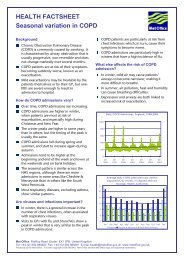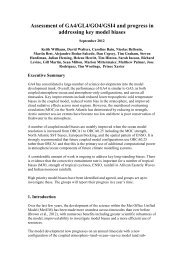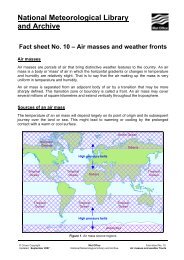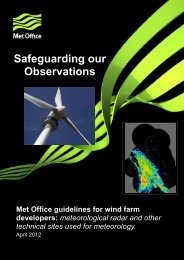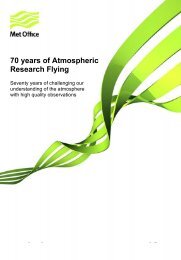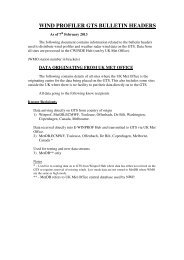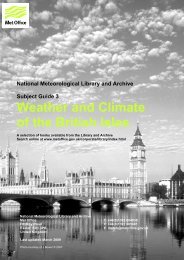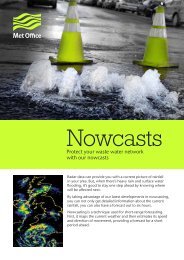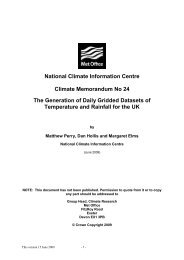Description and assessment of the OSTIA reanalysis. - Met Office
Description and assessment of the OSTIA reanalysis. - Met Office
Description and assessment of the OSTIA reanalysis. - Met Office
Create successful ePaper yourself
Turn your PDF publications into a flip-book with our unique Google optimized e-Paper software.
quality control procedures including a maximum <strong>and</strong> minimum value check <strong>and</strong> a background check<br />
against <strong>the</strong> previous day’s analysis after relaxation to climatology (section 3.3), before inclusion in<br />
<strong>the</strong> <strong>OSTIA</strong> <strong>reanalysis</strong>. The st<strong>and</strong>ard deviation provided for each cell with <strong>the</strong> Pathinder data was<br />
used as <strong>the</strong> observation error in <strong>the</strong> <strong>OSTIA</strong> <strong>reanalysis</strong>. For instances where <strong>the</strong> value in <strong>the</strong> cell was<br />
derived from few observations <strong>and</strong> hence had a st<strong>and</strong>ard deviation close to 0, an error <strong>of</strong> 0.33 K<br />
was assumed, following Kearns et al. (2000).<br />
Pathfinder v5.0 includes some information on sea ice. This is used in <strong>the</strong> Pathfinder data processing<br />
procedure to exclude pixels from <strong>the</strong> internal 3 week reference SST check mentioned<br />
above. The aim <strong>of</strong> this approach is to reduce <strong>the</strong> likelihood <strong>of</strong> mis-classified SST pixels, for example<br />
those with high quality levels but falling on <strong>the</strong> ice mask (NODC, 2009). The ice data is not<br />
used to specifically flag <strong>the</strong> data as poor quality, although <strong>the</strong>re are plans to include this in future<br />
versions <strong>of</strong> <strong>the</strong> Pathfinder dataset (NODC, 2009). Thus ice-covered pixels should only be assigned<br />
quality flags <strong>of</strong> 3 or below. However, it was found during investigations <strong>of</strong> a preliminary run <strong>of</strong> <strong>the</strong><br />
<strong>OSTIA</strong> <strong>reanalysis</strong> that this processing was unsuccessful in <strong>the</strong> Arctic in <strong>the</strong> boreal summer. A considerable<br />
number <strong>of</strong> pixels in <strong>the</strong> ice-covered region are flagged as high quality in <strong>the</strong> summertime,<br />
see section 3.2 for a description <strong>of</strong> how <strong>the</strong> <strong>OSTIA</strong> system quality controlled <strong>the</strong>se erroneous SST<br />
observations.<br />
In addition, NODC (2009) notes <strong>the</strong> presence <strong>of</strong> erroneously cold SST values in high latitudes in<br />
<strong>the</strong> Pathfinder dataset <strong>and</strong> recommends masking <strong>the</strong>m out. As mentioned in section 3.2, a minimum<br />
SST <strong>of</strong> -2.0 o C was set for all datasets used in <strong>the</strong> <strong>OSTIA</strong> <strong>reanalysis</strong> which removes <strong>the</strong> spurious<br />
values.<br />
2.3 (A)ATSR multi-mission series<br />
The (A)ATSR multi-mission archive is a ESA/NEODC project to produce a 15-year archive <strong>of</strong> sea<br />
surface temperatures using <strong>the</strong> (A)ATSR series <strong>of</strong> instruments at levels <strong>of</strong> accuracy <strong>of</strong> 0.3 K or<br />
better (NEODC, 2011). The dataset begins in 1991 with <strong>the</strong> launch <strong>of</strong> <strong>the</strong> ATSR-1 instrument,<br />
onboard <strong>the</strong> ERS-1 satellite. This was followed in 1995 by <strong>the</strong> ATSR-2, onboard ERS-2 <strong>and</strong> AATSR<br />
onboard Envisat in 2002.<br />
The ATSR series <strong>of</strong> instruments are multichannel radiometers which have three waveb<strong>and</strong>s in<br />
<strong>the</strong> infra-red part <strong>of</strong> <strong>the</strong> spectrum (Robinson, 2004). All three ATSR instruments employ <strong>the</strong> same<br />
onboard calibration procedure for <strong>the</strong> <strong>the</strong>rmal channels, whereby two high precision blackbodies<br />
are viewed every scan cycle (NEODC, 2011; Robinson, 2004). The temperatures <strong>of</strong> <strong>the</strong> blackbodies<br />
approximately straddle <strong>the</strong> ground temperature range to precisely calibrate <strong>the</strong> brightness<br />
temperatures for each channel (Robinson, 2004). A cooling procedure is used to lower <strong>the</strong> detector<br />
temperature, <strong>the</strong>reby improving <strong>the</strong> stability <strong>of</strong> <strong>the</strong> calibration procedure (Robinson, 2004).<br />
The instruments employ a unique conical scanning geometry, using a single detector to view <strong>the</strong><br />
same area <strong>of</strong> ground twice; once at a forward angle <strong>of</strong> around 55 o <strong>and</strong> once at nadir (around<br />
© c Crown Copyright 2011 17




